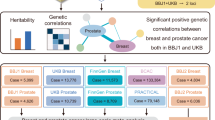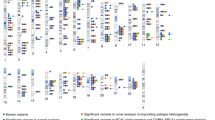Abstract
To identify new genetic risk factors for cervical cancer, we conducted a genome-wide association study in the Han Chinese population. The initial discovery set included 1,364 individuals with cervical cancer (cases) and 3,028 female controls, and we selected a 'stringently matched samples' subset (829 cases and 990 controls) from the discovery set on the basis of principal component analysis; the follow-up stages included two independent sample sets (1,824 cases and 3,808 controls for follow-up 1 and 2,343 cases and 3,388 controls for follow-up 2). We identified strong evidence of associations between cervical cancer and two new loci: 4q12 (rs13117307, Pcombined, stringently matched = 9.69 × 10−9, per-allele odds ratio (OR)stringently matched = 1.26) and 17q12 (rs8067378, Pcombined, stringently matched = 2.00 × 10−8, per-allele ORstringently matched = 1.18). We additionally replicated an association between HLA-DPB1 and HLA-DPB2 (HLA-DPB1/2) at 6p21.32 and cervical cancer (rs4282438, Pcombined, stringently matched = 4.52 × 10−27, per-allele ORstringently matched = 0.75). Our findings provide new insights into the genetic etiology of cervical cancer.
This is a preview of subscription content, access via your institution
Access options
Subscribe to this journal
Receive 12 print issues and online access
$209.00 per year
only $17.42 per issue
Buy this article
- Purchase on Springer Link
- Instant access to full article PDF
Prices may be subject to local taxes which are calculated during checkout


Similar content being viewed by others
References
Arbyn, M. et al. Worldwide burden of cervical cancer in 2008. Ann. Oncol. 22, 2675–2686 (2011).
Parkin, D.M., Bray, F., Ferlay, J. & Pisani, P. Global cancer statistics, 2002. CA Cancer J. Clin. 55, 74–108 (2005).
zur Hausen, H. Papillomaviruses causing cancer: evasion from host-cell control in early events in carcinogenesis. J. Natl. Cancer Inst. 92, 690–698 (2000).
zur Hausen, H. Papillomaviruses and cancer: from basic studies to clinical application. Nat. Rev. Cancer 2, 342–350 (2002).
Walboomers, J.M. et al. Human papillomavirus is a necessary cause of invasive cervical cancer worldwide. J. Pathol. 189, 12–19 (1999).
Chen, T.M., Pecoraro, G. & Defendi, V. Genetic analysis of in vitro progression of human papillomavirus–transfected human cervical cells. Cancer Res. 53, 1167–1171 (1993).
Baseman, J.G. & Koutsky, L.A. The epidemiology of human papillomavirus infections. J. Clin. Virol. 32 (suppl. 1), S16–S24 (2005).
Ho, G.Y., Bierman, R., Beardsley, L., Chang, C.J. & Burk, R.D. Natural history of cervicovaginal papillomavirus infection in young women. N. Engl. J. Med. 338, 423–428 (1998).
Kulasingam, S.L. et al. Evaluation of human papillomavirus testing in primary screening for cervical abnormalities: comparison of sensitivity, specificity, and frequency of referral. J. Am. Med. Assoc. 288, 1749–1757 (2002).
Dalstein, V. et al. Persistence and load of high-risk HPV are predictors for development of high-grade cervical lesions: a longitudinal French cohort study. Int. J. Cancer 106, 396–403 (2003).
Magnusson, P.K., Lichtenstein, P. & Gyllensten, U.B. Heritability of cervical tumours. Int. J. Cancer 88, 698–701 (2000).
Ivansson, E.L., Juko-Pecirep, I., Erlich, H.A. & Gyllensten, U.B. Pathway-based analysis of genetic susceptibility to cervical cancer in situ: HLA-DPB1 affects risk in Swedish women. Genes Immun. 12, 605–614 (2011).
Freedman, M.L. et al. Assessing the impact of population stratification on genetic association studies. Nat. Genet. 36, 388–393 (2004).
de Bakker, P.I. et al. Practical aspects of imputation-driven meta-analysis of genome-wide association studies. Hum. Mol. Genet. 17, R122–R128 (2008).
Sugihara, K. et al. The exocyst complex binds the small GTPase RalA to mediate filopodia formation. Nat. Cell Biol. 4, 73–78 (2002).
Munson, M. & Novick, P. The exocyst defrocked, a framework of rods revealed. Nat. Struct. Mol. Biol. 13, 577–581 (2006).
Rosse, C. et al. An aPKC-exocyst complex controls paxillin phosphorylation and migration through localised JNK1 activation. PLoS Biol. 7, e1000235 (2009).
Zuo, X. et al. Exo70 interacts with the Arp2/3 complex and regulates cell migration. Nat. Cell Biol. 8, 1383–1388 (2006).
Ishikawa, H., Ma, Z. & Barber, G.N. STING regulates intracellular DNA-mediated, type I interferon–dependent innate immunity. Nature 461, 788–792 (2009).
Bourgault Villada, I. et al. Spontaneous regression of grade 3 vulvar intraepithelial neoplasia associated with human papillomavirus-16–specific CD4+ and CD8+ T-cell responses. Cancer Res. 64, 8761–8766 (2004).
Nicol, A.F. et al. Immune factors involved in the cervical immune response in the HIV/HPV co-infection. J. Clin. Pathol. 61, 84–88 (2008).
Roeth, J.F. & Collins, K.L. Human immunodeficiency virus type 1 Nef: adapting to intracellular trafficking pathways. Microbiol. Mol. Biol. Rev. 70, 548–563 (2006).
Fenard, D. et al. Nef is physically recruited into the immunological synapse and potentiates T cell activation early after TCR engagement. J. Immunol. 175, 6050–6057 (2005).
Schrager, J.A. & Marsh, J.W. HIV-1 Nef increases T cell activation in a stimulus-dependent manner. Proc. Natl. Acad. Sci. USA 96, 8167–8172 (1999).
Mukerji, J., Olivieri, K.C., Misra, V., Agopian, K.A. & Gabuzda, D. Proteomic analysis of HIV-1 Nef cellular binding partners reveals a role for exocyst complex proteins in mediating enhancement of intercellular nanotube formation. Retrovirology 9, 33 (2012).
Di Bonito, P. et al. Anti-tumor CD8+ T cell immunity elicited by HIV-1–based virus-like particles incorporating HPV-16 E7 protein. Virology 395, 45–55 (2009).
Tamura, M. et al. Members of a novel gene family, Gsdm, are expressed exclusively in the epithelium of the skin and gastrointestinal tract in a highly tissue-specific manner. Genomics 89, 618–629 (2007).
Carl-McGrath, S., Schneider-Stock, R., Ebert, M. & Rocken, C. Differential expression and localisation of gasdermin-like (GSDML), a novel member of the cancer-associated GSDMDC protein family, in neoplastic and non-neoplastic gastric, hepatic, and colon tissues. Pathology 40, 13–24 (2008).
Sun, Q., Yang, J., Xing, G., Zhang, L. & He, F. Expression of GSDML associates with tumor progression in uterine cervix cancer. Transl. Oncol. 1, 73–83 (2008).
Saeki, N. et al. GASDERMIN, suppressed frequently in gastric cancer, is a target of LMO1 in TGF-β–dependent apoptotic signalling. Oncogene 26, 6488–6498 (2007).
Purcell, S. et al. PLINK: a tool set for whole-genome association and population-based linkage analyses. Am. J. Hum. Genet. 81, 559–575 (2007).
de Bakker, P.I. et al. A high-resolution HLA and SNP haplotype map for disease association studies in the extended human MHC. Nat. Genet. 38, 1166–1172 (2006).
Wirtz, C. & Sayer, D. Data analysis of HLA sequencing using Assign-SBT v3.6+ from Conexio. Methods Mol. Biol. 882, 87–121 (2012).
Price, A.L. et al. Principal components analysis corrects for stratification in genome-wide association studies. Nat. Genet. 38, 904–909 (2006).
Solovieff, N. et al. Clustering by genetic ancestry using genome-wide SNP data. BMC Genet. 11, 108 (2010).
Saxena, R. et al. Genome-wide association analysis identifies loci for type 2 diabetes and triglyceride levels. Science 316, 1331–1336 (2007).
Shi, Y.Y. & He, L. SHEsis, a powerful software platform for analyses of linkage disequilibrium, haplotype construction, and genetic association at polymorphism loci. Cell Res. 15, 97–98 (2005).
Mantel, N. & Haenszel, W. Statistical aspects of the analysis of data from retrospective studies of disease. J. Natl. Cancer Inst. 22, 719–748 (1959).
Setakis, E., Stirnadel, H. & Balding, D.J. Logistic regression protects against population structure in genetic association studies. Genome Res. 16, 290–296 (2006).
Harley, J.B. et al. Genome-wide association scan in women with systemic lupus erythematosus identifies susceptibility variants in ITGAM, PXK, KIAA1542 and other loci. Nat. Genet. 40, 204–210 (2008).
Marchini, J., Howie, B., Myers, S., McVean, G. & Donnelly, P. A new multipoint method for genome-wide association studies by imputation of genotypes. Nat. Genet. 39, 906–913 (2007).
Acknowledgements
This study was funded by the Fund of the Key Basic Research and Development Program Foundation of China (973 Program) from the Ministry of Science and Technology of China (2009CB521808 and 2013CB911304), grants from the National Natural Science Foundation of China (81230038, 81025011, 81090414, 30973472, 81071663, 81130022, 81121001, 81230052, 81272302, 31000553, 81172464 and 81101964), Key Projects in the National Science and Technology Pillar Program during the Eleventh Five-Year Plan Period (2008BAI57B01), the High-Tech Research and Development Program of China (863 Program) (2012AA020801 and 2012AA02A515) and the Fund of the Key Laboratory of Cancer Invasion and Metastasis from Hubei Province and Tongji Hospital (HB001 and xkdy28). This work was also partially supported by the Hubei Research and Development Program (2008BCC005, 2009BCC001 and 2010BCB006), the Program for Changjiang Scholars and Innovative Research Team in University (IRT1025), the Foundation for the Author of National Excellent Doctoral Dissertation of China (201026), the Program for New Century Excellent Talents in University (NCET-09-0550) and the Shanghai Rising-Star Program (12QA1401900). We thank all participants recruited for this study. We would like to thank S. Liu, G. Wu, Z. Wang, S. Xie, S. Chen, Q. Wu, Y. Lu, B. Cao, Y. Li, Q. Chen, D. Zhu, M. Gong, S. Sun, Y. Wang, Y. Qin, R. Yang, J. Feng, T. Wang, L. Shi, J. Jiang, F. Rong, W. Zhou, M. Qian, X. Wu, X. Xia, Y. Yan, Y. Fan, M. Cao, C. Sun, Q. Ling, J. Yang, B. Zhou, Z. Zeng, L. Tang, L. Yu, Y. Han, J. Zhou, Y. Fang, P. Chen and Y. Meng for their useful help.
Author information
Authors and Affiliations
Contributions
D.M. took full responsibility for the study, especially in conceiving, designing and supervising the research together with Y. Shi and X.X. S.L., L. Li, Z. Hu, Shixuan Wang and J.Z. participated in the study design. D.M., S.L., X.X., L. Li, Z. Hu and Shixuan Wang supervised the diagnosis of patients and subject recruitment. Y. Shi and S.L. supervised the experiments and data analyses. Y. Shi, Zhiqiang Li, X. Li, S.L., T.H. and Z. Han performed statistical analyses, and the results were interpreted by D.M., S.L., Y. Shi and X.X. D.M., X.X., L.H., Y. Shi, L. Li, H.S., Z. Hu, J.Z., Shixuan Wang, S.L., Jihong Liu, D. Lin, C. Wu, Y.C., H. Xing, S.Z., P.Q., Y. Fan, W.D., K.S., X.S., D.W., H.D., Z. Lin, D.D., L.X., X. Cheng, W. Lv, X. Han, G.T., X.M., H.W., F.Q., L. Liu, X. Chen, Jibin Liu, J.W., Yan Shen, L.Y., Z.Y., J.Y., G.M., X. Hu, Y. Feng, H.H., Y. Jiang, Z. Lei, C.L., Y.Z., Z.W., C.Y., S.C., Yuanming Shen, S. Wu, H. Xu, C. Wang and Q.S. contributed reagents, materials and analysis tools and provided samples from different hospitals. S.L., Y. Shi, T.H., Y. Jia, Shaoshuai Wang, R.Y., Z. Hu, L.W., X. Li, K.H., Z.C., Jian Shen, Q.Z., H.Z., F.T., E.G., D. Liu, J.J., Wenjin Li, Jiawei Shen, S.P., Zhuang Li, L.Z., X. Luan, Y.W., M.C., J.C., Jihong Liu and Zheng Li performed the experiments. D.W., X.M. and H.D. provided technical support. The manuscript was drafted by S.L. and Zhiqiang Li under the supervision of D.M., Y. Shi and X.X. All authors critically reviewed the article and approved the final manuscript.
Corresponding authors
Ethics declarations
Competing interests
The authors declare no competing financial interests.
Supplementary information
Supplementary Text and Figures
Supplementary figures 1-5, Supplementary Tables 1-7, 9-12, and 14 (PDF 1288 kb)
Supplementary Table 8
Supplementary Table 8 (XLS 48 kb)
Supplementary Table 13
Supplementary Table 13 (XLS 336 kb)
Rights and permissions
About this article
Cite this article
Shi, Y., Li, L., Hu, Z. et al. A genome-wide association study identifies two new cervical cancer susceptibility loci at 4q12 and 17q12. Nat Genet 45, 918–922 (2013). https://doi.org/10.1038/ng.2687
Received:
Accepted:
Published:
Issue Date:
DOI: https://doi.org/10.1038/ng.2687
This article is cited by
-
Characteristics of HPV integration in cervical adenocarcinoma and squamous carcinoma
Journal of Cancer Research and Clinical Oncology (2023)
-
Exploration of biomarkers for the diagnosis, treatment and prognosis of cervical cancer: a review
Discover Oncology (2022)
-
The association of telomere maintenance and TERT expression with susceptibility to human papillomavirus infection in cervical epithelium
Cellular and Molecular Life Sciences (2022)
-
Association of three micro-RNA gene polymorphisms with the risk of cervical cancer: a meta-analysis and systematic review
World Journal of Surgical Oncology (2021)
-
Cervical carcinoma risk associate with genetic polymorphisms of NEIL2 gene in Chinese population and its significance as predictive biomarker
Scientific Reports (2020)



